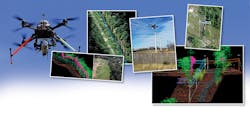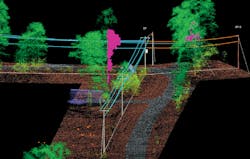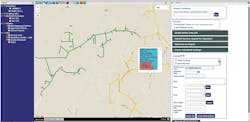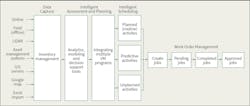Leveraging the Potential of Emerging Technologies
Improvements in sensing, measurement, data management, processing and communications technologies are creating new opportunities for utilities to lower vegetation management costs and forecast budgets more accurately. In response, Pedernales Electric Cooperative Inc. (PEC) has developed new approaches to leverage emerging technologies for its long-term vegetation management requirements.
PEC recognized the need for appropriate data management, software and decision-support tools to help facilitate its evolution toward smarter vegetation management at an acceptable pace and budget. Combined with other tools and capabilities, PEC decided to use Tree Asset Manager (TreeAM) — an innovative software platform developed by EcoLayers Inc. — to address many of the utility’s issues and challenges, and to meet its overall vision of vegetation management.
Core Strategies
The key objectives of PEC’s vegetation management strategies are to lower the risk and consequences of failure, lower maintenance costs and normalize the budgeting process. PEC aims to achieve these objectives through four core strategies:
- Reactive maintenance is the response after a failure occurs, such as an outage caused by a fallen tree, which can be the most expensive form of maintenance, especially if the cost of a failure is high, such as an outage or fire.
- Routine maintenance is performed along line sections every two to five years, based on predefined vegetation management zones and areas.
- Proactive maintenance seeks to improve the prioritization, frequency and type of activities for routine maintenance, based on metrics derived from an analysis of historical data, line conditions, growth rates and other factors.
- Predictive maintenance targets specific maintenance activities for utility assets and vegetation before a failure occurs, prioritized by the cost of failure. Because only a small proportion of trees are responsible for failure, predictive maintenance has the potential to reduce maintenance budgets substantially while improving system reliability.
Issues and Challenges
PEC recognized successful implementation of its vegetation management strategies must address several issues and challenges over the long term within the broader framework of its organizational mission, annual budgets, regulatory requirements, environmental sustainability and other factors. Some of the areas that the technology and software used for vegetation management strategies should adequately address are data collection, data management, analytics, minimizing manual work and people touch points, and maintaining continuity and a holistic approach.
Like most utilities, PEC historically tracked cost and performance data related to outage statistics and trimming cycles, primarily to support its reactive and routine maintenance strategies. This data will not help PEC to implement its proactive and predictive strategies as they require a substantially broader data set, for example, tree species, size, health, regional growth rates and location relative to the line, line age and condition, local storm aspects, and trends in environmental conditions, maintenance history and failure-related data. Additionally, individual vegetation management programs such as tree growth regulators (TGRs), herbicides and pesticides will have their own dedicated data sets.
Vegetation management data collection challenges and issues include the following:
- Supporting timely, accurate and adequate collection of data for the intended purposes
- Enabling field crews to collect data in areas with poor or no internet and GPS signals
- Quick and simple data-capture mechanisms
- Timely, efficient and error-free transfer of data from field crews to other teams
- Consistency between data collected for the same line sections for different vegetation management programs.
The implementation of PEC’s vegetation management strategies and related data collection is expected to take many years, as determined by available budgets, prevailing viable technologies, vegetation management needs and other factors. If not managed properly over the long term, the value of collected data can decline quickly over time. Long-term data management for vegetation management poses challenges for the large scale involved in circuit miles and number of trees; multiple sources of data likely to have different standards and formats; changes in type and frequency of data collection; and the large number of users.
Analytical and modeling tools provide intelligence for better decisions and budget forecasts. This is particularly important for proactive and predictive strategies. For example, PEC is taking steps toward implementing proactive strategies using results from a recent study that prioritizes trim cycles by line section based on costs, tree growth rates, health and line conditions. Other analytical tools will be needed in the near term to identify and prioritize TGR trees and herbicide-treatment areas, track the initial and subsequent quantities as well as the schedules for treatment protocols, and estimate costs. The selection and use of analytics come with some challenges:
- Managing interdependencies among data, analytics and business processes due to changes in technologies, budgets and vegetation management needs
- Collecting the right data, developing the models and validating model recommendations over many years, particularly for predictive strategies
- Simplifying use by vegetation management professionals once the analytics and models have been set up by the domain experts (modelers).
PEC’s vegetation management work is distributed among many internal and contractor teams. Considering the scale and scope of their activities, the coordination and interactions between these teams using manual methods such as paper, emails, meetings and shared online workspaces is highly inefficient, prone to errors and a major obstacle for the implementation of proactive and predictive strategies.
Like any organization, PEC anticipates changes to staff, contractors and departmental responsibilities over the course of implementing its vegetation management strategies. The ability to transfer knowledge and best practices gained over many years without major disruptions to ongoing operations and the long-term strategies is important. Currently, with data residing in compartmentalized silos — for example, Excel spreadsheets, geographic information system (GIS) files and enterprise databases — a seamless transfer of knowledge is difficult.
Though vegetation management as envisioned by PEC involves a wide range of data, teams, strategies and vegetation management programs, collectively they must serve the same goals. Hence, there is a need to take an integrated, holistic approach to all aspects of vegetation management. This is also practically impossible to achieve using traditional tools such as paper forms, Excel spreadsheets and GIS.
Emerging Technologies
Most of the issues and challenges related to the implementation of PEC’s strategies can be addressed cost effectively by existing and emerging technologies with which the vegetation management industry should be familiar. Examples include GIS, big data, cloud computing, wireless, digital sensors such as light detection and ranging (LiDAR), unmanned autonomous vehicles (UAVs) and handheld devices with desktop-like performance. All of these technologies are commercially proven and exhibit declining cost-performance ratios.
The key to leveraging technologies is their proper application, specifically in the context of the problems to be solved. A closer look at the entirety of PEC’s vegetation management strategies — and vegetation management in general — indicates vegetation management is a reasonably complex, time-varying (changing), integrated system involving many stakeholders with an evolutionary path that cannot be clearly forecast today. Consequently, any technology solution must mirror these characteristics. That is, it must be capable of data, process and workflow integration; modular and customizable; open; and, most importantly, flexible (adaptive) to meet changing vegetation management needs over time. Internal software complexities can be hidden from users through proper design of user interfaces and other means.
The primary reason why most existing data management and software tools do not adequately address the issues and challenges facing PEC is because they approach individual vegetation management programs as stand-alone applications. For example, a stand-alone software package covering all aspects of line clearance still does not address the systemic needs of vegetation management. Another example is LiDAR data delivered as shape files without the means to integrate it with other vegetation management data, workflows and decision-support tools.
New technologies have the potential to disrupt an industry with positive outcomes. High-resolution digital sensing, measurement and imaging technologies — when properly integrated with big-data analytics and other system capabilities — hold such promise for vegetation management. These technologies can provide the following benefits:
- Highly accurate identification and prioritization of danger trees, potentially reducing the number of trees that need to be managed actively
- Frequent data updates relative to current manual surveys
- Development of improved predictive models because of better and more frequent data collection and the ability to rapidly validate model recommendations
- A significant reduction in manual work.
Implementing the Vision
PEC is using TreeAM to implement its vegetation management strategies. TreeAM is a new class of web-based software designed to manage trees and vegetation as environmental assets, whose conditions and interactions with built assets (power lines) are constantly changing in unpredictable ways. Environmental assets also exist as part of a complex, time-varying system. This fundamental shift in perspective, combined with other tools and capabilities, enables TreeAM to address many of the aforementioned issues and challenges.
Other tools and capabilities seamlessly integrated with TreeAM include GIS; an enterprise-grade asset management system; a data and workflow model that can be adapted to changing requirements; a framework for incorporating custom third-party analytical tools and models; and an offline package that provides most of the online functionality in the field.
An open architecture makes it possible for TreeAM to be integrated with external systems and data sources such as enterprise databases, GIS, asset management systems, web services, UAV platforms and different vegetation management programs. A sophisticated permissions management system limits users’ visibility and access to data and features to the task at hand, providing a user-friendly experience.
PEC is using TreeAM initially for field data collection and to support its existing vegetation management programs, which include line clearance by circuit miles; line clearance by individual trees or groups of trees; and, in the near future, TGR application, and mowing and herbicide applications. The programs have all the functionality for inventorying, planning, tracking and assessments.
Realizing the Potential
Emerging technologies have the potential to reduce vegetation management costs and failure risks significantly. However, utilities should carefully consider the long-term and systemic aspects of their vegetation management strategies and programs. The choice of technologies should not exceed budgets or become obstacles to continuous improvement. Emerging technologies also have the potential to create a new paradigm for vegetation management consisting of the following:
- Sensor-based digital data acquisition on a large scale
- Highly accurate categorization of vegetation assets for the right maintenance activity at the right time
- Reduced manual work and people touch points
- Flexibility (adaptive) in meeting network, environmental, organizational and technological changes
- Integrated, holistic approaches to managing vegetation assets.
The adoption of new technologies and tools will require a well-planned, persistent effort over several years. It also is an organizational learning process that can start in small manageable steps at any time. PEC and EcoLayers are working to make this future of vegetation management a reality. ♦
George Leader is distribution/vegetation management supervisor at Pedernales Electric Cooperative Inc. in Johnson City, Texas, responsible for all aspects of planning, budgeting and implementation of the PEC vegetation management program. An International Society of Arboriculture certified arborist, Leader brings more than 36 years of experience in T&D system maintenance. Prior to joining PEC, he was the head lineman at Houston Lighting & Power (CenterPoint).
Joe Purohit is founder and CEO of EcoLayers Inc., a San Diego-based company developing innovative software for the integrated management of environmental assets. He brings more than 30 years of experience in commercializing innovative technology at General Electric, AT&T and BP. Purohit holds undergraduate and graduate degrees in electrical power engineering from the Indian Institute of Technology and the Rensselaer Polytechnic Institute, and a MBA degree from the Wharton School of Business.
About the Author
George Leader
Distribution/Vegetation Management Supervisor
George Leader is distribution/vegetation management supervisor at Pedernales Electric Cooperative Inc. in Johnson City, Texas, responsible for all aspects of planning, budgeting and implementation of the PEC vegetation management program. An International Society of Arboriculture certified arborist, Leader brings more than 36 years of experience in T&D system maintenance. Prior to joining PEC, he was the head lineman at Houston Lighting & Power (CenterPoint).
Joe Purohit
Founder and CEO
Joe Purohit is founder and CEO of EcoLayers Inc., a San Diego-based company developing innovative software for the integrated management of environmental assets. He brings more than 30 years of experience in commercializing innovative technology at General Electric, AT&T and BP. Purohit holds undergraduate and graduate degrees in electrical power engineering from the Indian Institute of Technology and the Rensselaer Polytechnic Institute, and a MBA degree from the Wharton School of Business.





